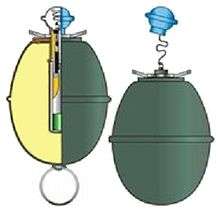Model 39 grenade
The Model 39 "Eihandgranate", M39 or Eierhandgranate 39 ("egg hand grenade") was a German fragmentation hand grenade introduced in 1939 and produced until the end of World War II.
| Eihandgranate Model 39 | |
|---|---|
Eihandgranate Model 39 with remnants of desert paint | |
| Type | Hand grenade |
| Place of origin | Nazi Germany |
| Service history | |
| In service | 1940-1945 |
| Used by | Nazi Germany, Soviet Union [1] |
| Wars | World War II |
| Production history | |
| Designed | 1939 |
| Variants | Standard, Fragmentation sleeve |
| Specifications | |
| Mass | 230 g (8.1 oz) |
| Height | 76 mm (3.0 in) |
| Diameter | 60 mm (2.4 in) |
| Filling | Donarit - (relatively similar to amatol) |
| Filling weight | 112 g (4.0 oz) |
Detonation mechanism | instant, 1, 4.5, 7.5 or 10 second delay |
Description
The Eihandgranate were issued to the Fallschirmjäger from early till the end of the war. The grenade used the same fuse assembly (the BZE 39) as the Model 43 Stielhandgranate ("Stick Grenade"), which was screwed into the top of the sheet-metal body.
To activate, the dome-shaped cap was unscrewed and pulled with a coiled pull-cord that is pulled before throwing. The color of the cap indicated the burning time of the type of fuze fitted. Typically, a delay of around 4 seconds was used. It could also be used in place of the bottom side screw cap on the "Stielhandgranate" stick grenades.
If it was to be used as a fixed booby-trap then an instantaneous or 1 second fuze would be fitted. Sometimes, this style of grenade would be discarded in plain view for the enemy to use, particularly on the Eastern Front. Another type of trap was to wire a short-fuze grenade to a door-frame in an abandoned building with the pull-cord attached to the door. When the door was breached by opposing troops the grenade would detonate right next to the enemy.
The offensive (high explosive) version of the grenade used a small Donarit filling which was considered extremely ineffective in comparison to the standard stick grenade models: large amounts of these grenades would be thrown in a short amount of time or at once for the desired effect.
The defensive (fragmentation) version of the grenade had a fragmentation sleeve wrapped around the exterior of the grenade, which would turn into high speed shrapnel when the grenade exploded giving it a longer range and greater damage ability to the enemy.
Fuze cap colour-codes
- Red - 1 second delay (for coloured smoke, but also [booby-trap])
- Blue - 4.5 second (standard issue), no delay (booby-trap)
- Yellow - 7.5 seconds (used on the Hafthohlladung 3 - magnetic shaped charge)
- Grey - 10.0 seconds

See also
- Model 24 grenade
- Model 43 grenade
External links
Literature
- Terry Gander, Peter Chamberlain: Encyclopedia of German Weapons 1939–1945. 2nd Release, Special edition. Motorbuchverlag, Stuttgart 2006, ISBN 3-613-02481-0.
- D. Mitev, Bulgarian and German hand grenades – history, development, contemporary state, Vol. 1, 216 pages, ISBN 978-954-629-012-0, Sofia, 2008